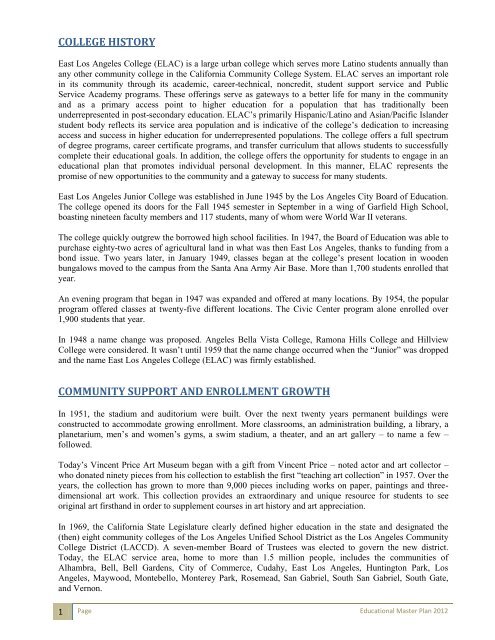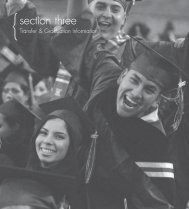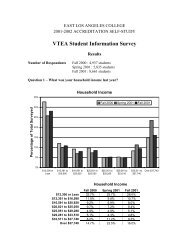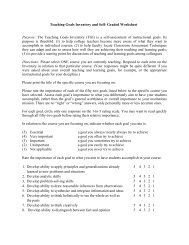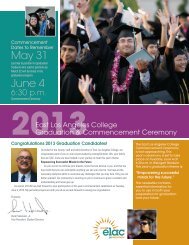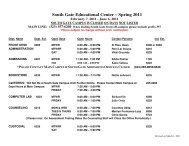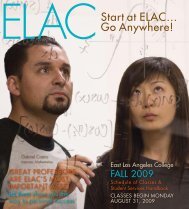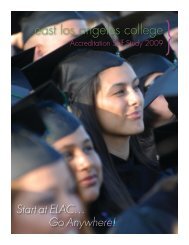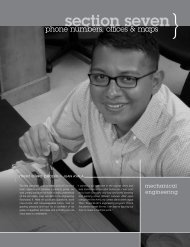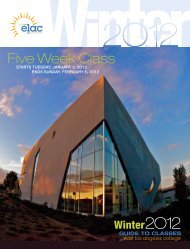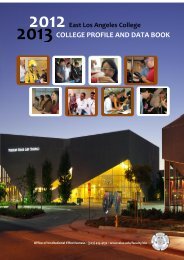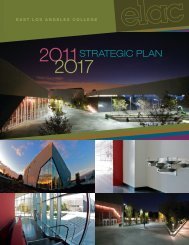ELAC Educational Master Plan - East Los Angeles College
ELAC Educational Master Plan - East Los Angeles College
ELAC Educational Master Plan - East Los Angeles College
You also want an ePaper? Increase the reach of your titles
YUMPU automatically turns print PDFs into web optimized ePapers that Google loves.
COLLEGE HISTORY<br />
<strong>East</strong> <strong>Los</strong> <strong>Angeles</strong> <strong>College</strong> (<strong>ELAC</strong>) is a large urban college which serves more Latino students annually than<br />
any other community college in the California Community <strong>College</strong> System. <strong>ELAC</strong> serves an important role<br />
in its community through its academic, career-technical, noncredit, student support service and Public<br />
Service Academy programs. These offerings serve as gateways to a better life for many in the community<br />
and as a primary access point to higher education for a population that has traditionally been<br />
underrepresented in post-secondary education. <strong>ELAC</strong>’s primarily Hispanic/Latino and Asian/Pacific Islander<br />
student body reflects its service area population and is indicative of the college’s dedication to increasing<br />
access and success in higher education for underrepresented populations. The college offers a full spectrum<br />
of degree programs, career certificate programs, and transfer curriculum that allows students to successfully<br />
complete their educational goals. In addition, the college offers the opportunity for students to engage in an<br />
educational plan that promotes individual personal development. In this manner, <strong>ELAC</strong> represents the<br />
promise of new opportunities to the community and a gateway to success for many students.<br />
<strong>East</strong> <strong>Los</strong> <strong>Angeles</strong> Junior <strong>College</strong> was established in June 1945 by the <strong>Los</strong> <strong>Angeles</strong> City Board of Education.<br />
The college opened its doors for the Fall 1945 semester in September in a wing of Garfield High School,<br />
boasting nineteen faculty members and 117 students, many of whom were World War II veterans.<br />
The college quickly outgrew the borrowed high school facilities. In 1947, the Board of Education was able to<br />
purchase eighty-two acres of agricultural land in what was then <strong>East</strong> <strong>Los</strong> <strong>Angeles</strong>, thanks to funding from a<br />
bond issue. Two years later, in January 1949, classes began at the college’s present location in wooden<br />
bungalows moved to the campus from the Santa Ana Army Air Base. More than 1,700 students enrolled that<br />
year.<br />
An evening program that began in 1947 was expanded and offered at many locations. By 1954, the popular<br />
program offered classes at twenty-five different locations. The Civic Center program alone enrolled over<br />
1,900 students that year.<br />
In 1948 a name change was proposed. <strong>Angeles</strong> Bella Vista <strong>College</strong>, Ramona Hills <strong>College</strong> and Hillview<br />
<strong>College</strong> were considered. It wasn’t until 1959 that the name change occurred when the “Junior” was dropped<br />
and the name <strong>East</strong> <strong>Los</strong> <strong>Angeles</strong> <strong>College</strong> (<strong>ELAC</strong>) was firmly established.<br />
COMMUNITY SUPPORT AND ENROLLMENT GROWTH<br />
In 1951, the stadium and auditorium were built. Over the next twenty years permanent buildings were<br />
constructed to accommodate growing enrollment. More classrooms, an administration building, a library, a<br />
planetarium, men’s and women’s gyms, a swim stadium, a theater, and an art gallery – to name a few –<br />
followed.<br />
Today’s Vincent Price Art Museum began with a gift from Vincent Price – noted actor and art collector –<br />
who donated ninety pieces from his collection to establish the first “teaching art collection” in 1957. Over the<br />
years, the collection has grown to more than 9,000 pieces including works on paper, paintings and threedimensional<br />
art work. This collection provides an extraordinary and unique resource for students to see<br />
original art firsthand in order to supplement courses in art history and art appreciation.<br />
In 1969, the California State Legislature clearly defined higher education in the state and designated the<br />
(then) eight community colleges of the <strong>Los</strong> <strong>Angeles</strong> Unified School District as the <strong>Los</strong> <strong>Angeles</strong> Community<br />
<strong>College</strong> District (LACCD). A seven-member Board of Trustees was elected to govern the new district.<br />
Today, the <strong>ELAC</strong> service area, home to more than 1.5 million people, includes the communities of<br />
Alhambra, Bell, Bell Gardens, City of Commerce, Cudahy, <strong>East</strong> <strong>Los</strong> <strong>Angeles</strong>, Huntington Park, <strong>Los</strong><br />
<strong>Angeles</strong>, Maywood, Montebello, Monterey Park, Rosemead, San Gabriel, South San Gabriel, South Gate,<br />
and Vernon.<br />
1 Page <strong>Educational</strong> <strong>Master</strong> <strong>Plan</strong> 2012


